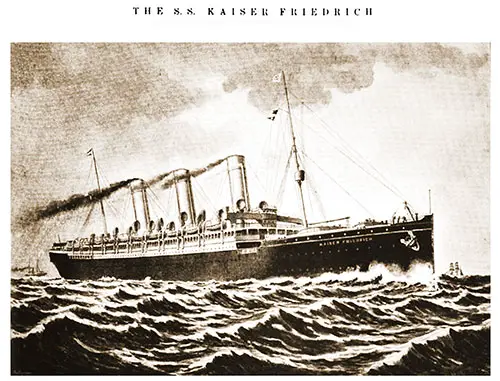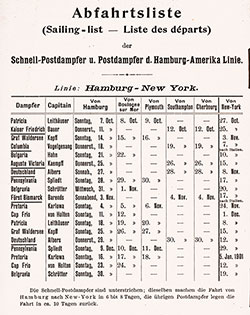SS Kaiser Friedrich Archival Collection

The SS Kaiser Friedrich at Sea. The Engineer, 13 May 1898. | GGA Image ID # 215dcff075
Kaiser Friedrich (1898) North German Lloyd
Built by F. Schichau, Danzig, Germany. Tonnage, 12,481. Dimensions: 581'x 63' (600' o.l.). Propulsion: Twin-screw, 21 1/2 knots. Quadruple expansion engines; 9 boilers; 72 furnaces; 225 lb. steam pressure in boilers. Masts and Funnels: Two masts and three funnels. Maiden voyage: Bremen-Southampton-New York, May 12, 1898. Final Voyage (HAPAG): Made her final sailing for North German Lloyd in June 1899. Service Changes: Withdrawn from service and returned to builders on account of the speed being unsatisfactory. The builders in August 1899 announced that the liner was to sail as a Hamburg-American steamship, who chartered the Kaiser Friedrich. Ownership Change: Sold to Cie Sud-Atlantique (French) in 1912. Renamed: Burdigala (1912). Fate: Torpedoed and sunk by submarine in the Mediterranean, November 14, 1916.

Hamburg American Line (HAPAG) Sailing Schedule, 7 October 1900 to 19 January 1901
The SS Kaiser Friedrich, operated by the Hamburg Amerika Linie / Hamburg American Line (HAPAG), was scheduled for transatlantic voyages between 7 October 1900 to 19 January 1901.
Atlantic Liner Kaiser Friedrich - 1899
Flying the house flag of the Hamburg-American line, the magnificent new liner Kaiser Friedrich recently came into the port of New York. After the usual stay, she took on passengers and cargo and sailed on schedule on her return trip on October 17. No speed records were broken coming over, nor does it seem likely that any will be by the new vessel.
We deliberately chose the adjective 'magnificent' to describe the Kaiser Friedrich, a ship that stands out among other liners. Despite not yet meeting expectations, this is largely due to what may initially seem like insignificant details. The Kaiser Friedrich is a prime example, not the first, of how the treatment of design details can lead to significant gains or losses.
It's worth noting that the Kaiser Friedrich, a product of the North German Lloyd Co., embarked on her maiden voyage in the summer of 1898. This journey, despite its disappointing outcome, marked a significant chapter in the ship's history and the maritime industry.
Owing to defects in the machinery, the vessel had to be slowed down for the greater part of the voyage, and her average speed was less than eighteen knots.
An account of this trip was published at the time, and the causes of the delay were referred to in detail. These were not due to imperfect workmanship or material but fundamental design features in the machinery equipment.
The North German Lloyds finally returned the vessel to the builders and are understood to have subsequently offered a price for the ship, which the builder would not accept.
Other offers were made for the liner, and finally, she was acquired by the Hamburg-American line at a price said to have been close to 7,500,000 marks. The terms of the sale have not been announced, but the vessel is reported to have been taken over on a guarantee.
When the Kaiser Friedrich came out, she was fitted with air pumps driven directly by the main engines. These were removed, and independent air pumps were substituted. Provision was also made for additional receiver space in the engines by attaching outside receivers on top of the cylinder castings.
The challenges in the engine room of the Kaiser Friedrich have been successfully overcome. The issue of holding steam at the working pressure was addressed by replacing the original boiler tubes with coned ends. A change has also been made in the draft system, and instead of a forced draft, the natural draft will likely be employed in the future, ensuring a smoother and more efficient journey.
This is not the first instance in which a liner built for one line was later permanently transferred to another, and while the Kaiser Friedrich will not likely be classed as a flyer, she ought to find a top place in the 19-knot class.
She will still be a fast boat, and as she was built primarily for passenger service—the cargo-carrying capacity being minimal—and fitted up luxuriously with every possible device for the comfort and convenience of ocean voyagers, she is likely to become a favorite.
Many would be satisfied to travel in a boat that was not being driven to the utmost limit.
For convenience, we repeat her dimensions: length: 600 ft.; beam: 64 ft.; depth: 41 ft. from keel to upper deck; gross tonnage: 12,000 tons; and displacement at 28 ft. draught: 17,000 tons. The accompanying reproduction of a recent photograph shows the Kaiser Friedrich's fine appearance at sea.
"Atlantic Liner Kaiser Friedrich," in Marine Engineering, New York: Aldrich & Donaldson, Vol. 4, No. 1, November 1899: 212-213.
